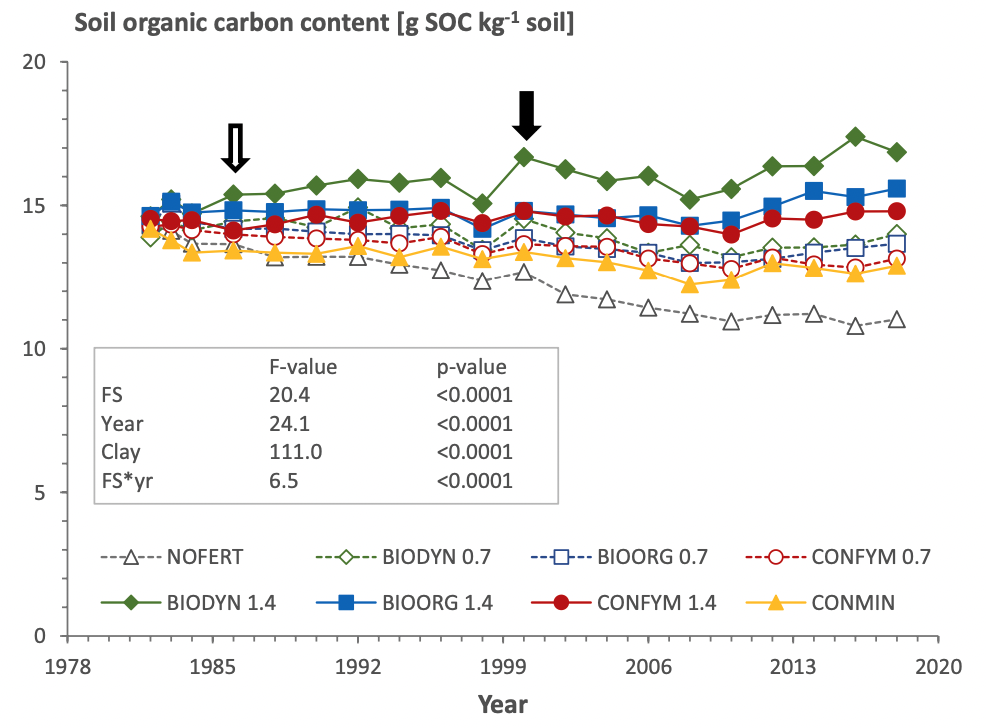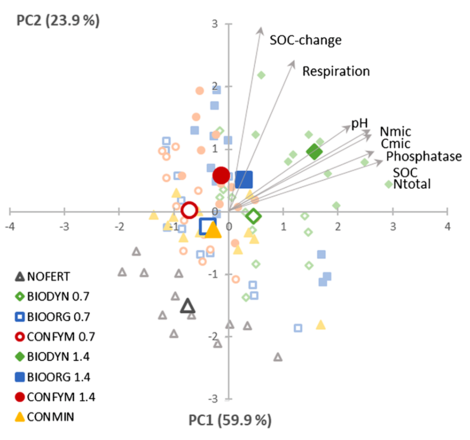DOK study compares soil quality of different cropping systems after 42 years of agricultural use
How do different farming systems influence soil quality over time? The DOK trial (BioDynamic, BioOrganic, Konventionell (German for conventional)) began in 1978 and, having been in operation for over 40 years, is one of the oldest comparative studies of its kind. Most of the test plots receive regular farmyard manure applications in varying amounts. The organically fertilised test plots are compared with both minerally fertilised plots and unfertilised control plots. In their work, the research team led by Hans-Martin Krause investigated how the proportion of soil organic carbon (SOC) has developed over time. The primary research questions were first, how long it takes for changes in SOC content to be detected and, second, which cultivation system is best able to stabilise or build up SOC. The researchers conclude that the application of composted farmyard manure – as is common in biodynamic agriculture – leads to a long-term enrichment of organic carbon in the soil and thus increases soil quality.
In recent decades, intensive agricultural practices worldwide have led to massive environmental damage. More sustainable farming systems need to be adapted and developed on a large scale, as global demand for more environmentally friendly food is steadily increasing. Biodynamic and organic farming methods are in some cases not as efficient as conventional agriculture, but they do not require chemical fertilisers and pesticides and promote high soil quality with strong biological activity. The proportion of organic carbon in the soil is considered the most important indicator for assessing soil quality. However, in most agricultural systems, a decline in SOC content has been observed. Data from long-term trials such as the DOK support the continued development of agricultural practices that can prevent SOC losses or even build up SOC levels. This is important because high-quality soil provides a functional environment and supports crop production.

Figure 1: Spatial arrangement of the test plots and cropping systems of the DOK trial in Therwil, Switzerland; NOFERT: unfertilised, BIODYN: biodynamic, BIOORG: organic, CONFYM: farmyard manure, CONMIN: mineral fertiliser.
A livestock unit (LU) is a measure for recording and comparing the livestock numbers on a farm. For farmyard manure, a livestock unit corresponds to the amount of manure or dung produced by this unit. The application of 0.7 LU of farmyard manure per hectare did not lead to an increase in the SOC content in any cropping system. However, the application of 1.4 LU of farmyard manure per hectare led to a stabilisation or increase in the SOC content in all farming systems, especially in biodynamic farming. In biodynamic cultivation, the increase in the SOC content was already achieved with 20 per cent less farmyard manure than in cultivation with farmyard manure (CONFYM). Compared to other farming systems, the biodynamic test plots show a higher soil quality and a higher SOC increase with the same farming intensity.
Due to the trial design, it is not possible to prove the effect of the biodynamic preparations in the DOK trial. The researchers assume that the observed higher soil quality and the higher SOC contents are related to a higher quality of the biodynamic farmyard manure.

Figure 2: Development of SOC content since 1978 in the different farming systems; the arrows indicate the years in which significant differences between biodynamic agriculture and conventional mineral (left arrow) or conventional farmyard manure management (right arrow were first observed. NOFERT: unfertilised, BIODYN: biodynamic, BIOORG: organic, CONFYM: farmyard manure, CONMIN: mineral fertiliser
Before plants can absorb organic fertiliser, it must first be mineralised. This is done by the microbial soil community. A vital soil with high microbial activity thus favours the nutrient uptake of the plants. While conventional farming systems use mineral fertilisers that are immediately available to plants, organic and biodynamic farming systems rely on the use of organic fertilisers and their transformation within the soil. The results of the DOK trial indicate that the soil microbial community can produce more biomass in biodynamic and organic farming systems than in a minerally fertilised farming system. The increased biomass leads to a higher mineralisation rate via increased soil activity and thus to faster plant availability of the supplied nutrients.
Conclusion
Overall, it can be said that the combination of livestock and arable crops has a positive effect on soil quality. However, long-term high soil quality is not only dependent on the amount of farmyard manure applied, but also to a large extent on its quality.
It took more than 20 years before the SOC content in the biodynamic test plots was significantly higher than that in the other test plots. The slow soil development underlines the importance of the mindful and sustainable use of soil as a resource.
Correction from 30.04.2024
Paul Mäder, Head of the Department of Soil Science at FiBL and direct contact person for the DOK trial, has kindly pointed out a few errors in this article. Based on his input, information on the amount of fertiliser and the biodynamic preparations was revised.
Details of the original research paper
- Authors: Krause, H.-M., Stehle, B., Mayer, J., Mayer, M., Steffens, M., Mäder, P., Fliessbach, A.
- Title: Biological soil quality and soil organic carbon change in biodynamic, organic, and conventional farming systems after 42 years
- Journal: Agronomy for Sustainable Development (2022) 42:117
- Link: https://doi.org/10.1007/s13593-022-00843-y
